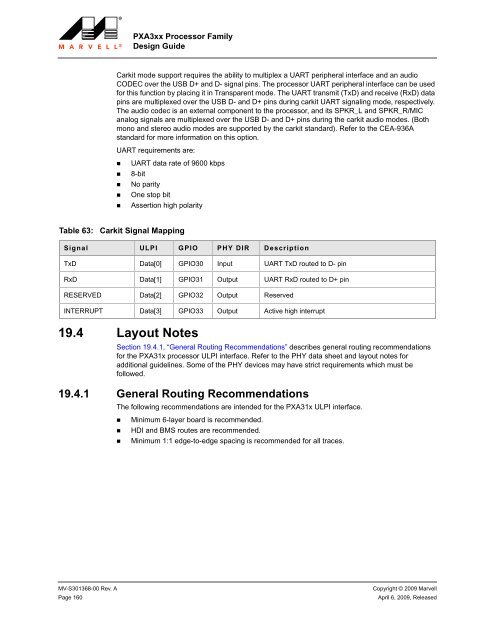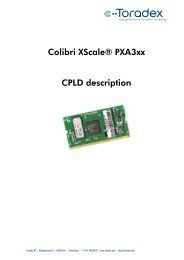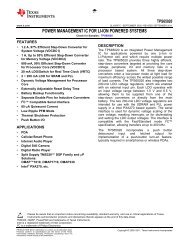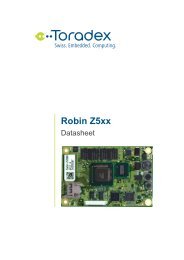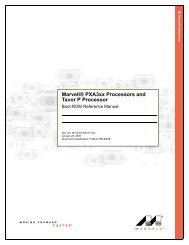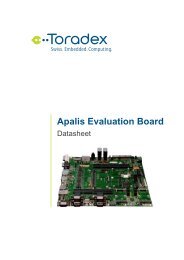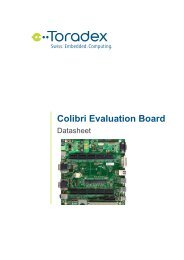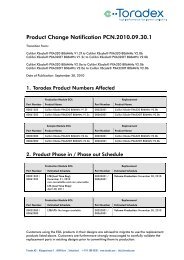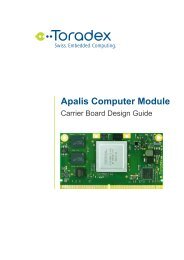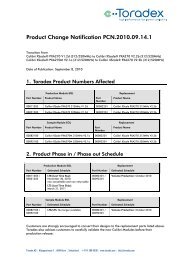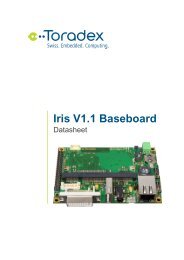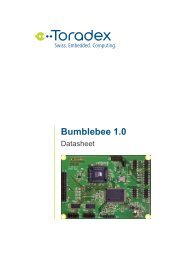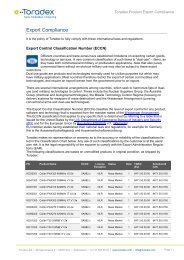- Page 5 and 6:
10.2 Signals ......................
- Page 7 and 8:
17.2 Signals ......................
- Page 9 and 10:
26.2 Signals ......................
- Page 11 and 12:
Copyright © 2009 MarvellDoc. No. M
- Page 13 and 14:
Figure 42: SPI Protocol Interface B
- Page 15:
TablesTable 1: How Design Guide Cha
- Page 18 and 19:
PXA3xx Processor FamilyDesign Guide
- Page 20 and 21:
PXA3xx Processor FamilyDesign Guide
- Page 22 and 23:
PXA3xx Processor FamilyDesign Guide
- Page 24 and 25:
PXA3xx Processor FamilyDesign Guide
- Page 26 and 27:
PXA3xx Processor FamilyDesign Guide
- Page 28 and 29:
PXA3xx Processor FamilyDesign Guide
- Page 30 and 31:
PXA3xx Processor FamilyDesign Guide
- Page 32 and 33:
PXA3xx Processor FamilyDesign Guide
- Page 34 and 35:
PXA3xx Processor FamilyDesign Guide
- Page 36 and 37:
PXA3xx Processor FamilyDesign Guide
- Page 38 and 39:
PXA3xx Processor FamilyDesign Guide
- Page 40 and 41:
PXA3xx Processor FamilyDesign Guide
- Page 42 and 43:
PXA3xx Processor FamilyDesign Guide
- Page 44 and 45:
PXA3xx Processor FamilyDesign Guide
- Page 46 and 47:
PXA3xx Processor FamilyDesign Guide
- Page 48 and 49:
PXA3xx Processor FamilyDesign Guide
- Page 50 and 51:
PXA3xx Processor FamilyDesign Guide
- Page 52 and 53:
PXA3xx Processor FamilyDesign Guide
- Page 54 and 55:
PXA3xx Processor FamilyDesign Guide
- Page 56 and 57:
PXA3xx Processor FamilyDesign Guide
- Page 58 and 59:
PXA3xx Processor FamilyDesign Guide
- Page 60 and 61:
PXA3xx Processor FamilyDesign Guide
- Page 62 and 63:
PXA3xx Processor FamilyDesign Guide
- Page 64 and 65:
PXA3xx Processor FamilyDesign Guide
- Page 66 and 67:
PXA3xx Processor FamilyDesign Guide
- Page 68 and 69:
PXA3xx Processor FamilyDesign Guide
- Page 70 and 71:
PXA3xx Processor FamilyDesign Guide
- Page 72 and 73:
PXA3xx Processor FamilyDesign Guide
- Page 74 and 75:
PXA3xx Processor FamilyDesign Guide
- Page 76 and 77:
PXA3xx Processor FamilyDesign Guide
- Page 78 and 79:
PXA3xx Processor FamilyDesign Guide
- Page 80 and 81:
PXA3xx Processor FamilyDesign Guide
- Page 82 and 83:
PXA3xx Processor FamilyDesign Guide
- Page 84 and 85:
PXA3xx Processor FamilyDesign Guide
- Page 86 and 87:
PXA3xx Processor FamilyDesign Guide
- Page 88 and 89:
PXA3xx Processor FamilyDesign Guide
- Page 90 and 91:
PXA3xx Processor FamilyDesign Guide
- Page 92 and 93:
PXA3xx Processor FamilyDesign Guide
- Page 94 and 95:
PXA3xx Processor FamilyDesign Guide
- Page 96 and 97:
PXA3xx Processor FamilyDesign Guide
- Page 98 and 99:
PXA3xx Processor FamilyDesign Guide
- Page 100 and 101:
PXA3xx Processor FamilyDesign Guide
- Page 102 and 103:
PXA3xx Processor FamilyDesign Guide
- Page 104 and 105:
PXA3xx Processor FamilyDesign Guide
- Page 106 and 107:
PXA3xx Processor FamilyDesign Guide
- Page 108 and 109:
PXA3xx Processor FamilyDesign Guide
- Page 110 and 111: PXA3xx Processor FamilyDesign Guide
- Page 112 and 113: PXA3xx Processor FamilyDesign Guide
- Page 114 and 115: PXA3xx Processor FamilyDesign Guide
- Page 116 and 117: PXA3xx Processor FamilyDesign Guide
- Page 118 and 119: PXA3xx Processor FamilyDesign Guide
- Page 120 and 121: PXA3xx Processor FamilyDesign Guide
- Page 122 and 123: PXA3xx Processor FamilyDesign Guide
- Page 124 and 125: PXA3xx Processor FamilyDesign Guide
- Page 126 and 127: PXA3xx Processor FamilyDesign Guide
- Page 128 and 129: PXA3xx Processor FamilyDesign Guide
- Page 130 and 131: PXA3xx Processor FamilyDesign Guide
- Page 132 and 133: PXA3xx Processor FamilyDesign Guide
- Page 134 and 135: PXA3xx Processor FamilyDesign Guide
- Page 136 and 137: PXA3xx Processor FamilyDesign Guide
- Page 138 and 139: PXA3xx Processor FamilyDesign Guide
- Page 140 and 141: PXA3xx Processor FamilyDesign Guide
- Page 142 and 143: PXA3xx Processor FamilyDesign Guide
- Page 144 and 145: PXA3xx Processor FamilyDesign Guide
- Page 146 and 147: PXA3xx Processor FamilyDesign Guide
- Page 148 and 149: PXA3xx Processor FamilyDesign Guide
- Page 150 and 151: PXA3xx Processor FamilyDesign Guide
- Page 152 and 153: PXA3xx Processor FamilyDesign Guide
- Page 154 and 155: PXA3xx Processor FamilyDesign Guide
- Page 156 and 157: PXA3xx Processor FamilyDesign Guide
- Page 158 and 159: PXA3xx Processor FamilyDesign Guide
- Page 162 and 163: PXA3xx Processor FamilyDesign Guide
- Page 164 and 165: PXA3xx Processor FamilyDesign Guide
- Page 166 and 167: PXA3xx Processor FamilyDesign Guide
- Page 168 and 169: PXA3xx Processor FamilyDesign Guide
- Page 170 and 171: PXA3xx Processor FamilyDesign Guide
- Page 172 and 173: PXA3xx Processor FamilyDesign Guide
- Page 174 and 175: PXA3xx Processor FamilyDesign Guide
- Page 176 and 177: PXA3xx Processor FamilyDesign Guide
- Page 178 and 179: PXA3xx Processor FamilyDesign Guide
- Page 180 and 181: PXA3xx Processor FamilyDesign Guide
- Page 182 and 183: PXA3xx Processor FamilyDesign Guide
- Page 184 and 185: PXA3xx Processor FamilyDesign Guide
- Page 186 and 187: PXA3xx Processor FamilyDesign Guide
- Page 188 and 189: PXA3xx Processor FamilyDesign Guide
- Page 190 and 191: PXA3xx Processor FamilyDesign Guide
- Page 192 and 193: PXA3xx Processor FamilyDesign Guide
- Page 194 and 195: PXA3xx Processor FamilyDesign Guide
- Page 196 and 197: PXA3xx Processor FamilyDesign Guide
- Page 198 and 199: PXA3xx Processor FamilyDesign Guide
- Page 200 and 201: PXA3xx Processor FamilyDesign Guide
- Page 202 and 203: PXA3xx Processor FamilyDesign Guide
- Page 204 and 205: PXA3xx Processor FamilyDesign Guide
- Page 206 and 207: PXA3xx Processor FamilyDesign Guide
- Page 208 and 209: PXA3xx Processor FamilyDesign Guide
- Page 210 and 211:
PXA3xx Processor FamilyDesign Guide
- Page 212 and 213:
PXA3xx Processor FamilyDesign Guide
- Page 214 and 215:
PXA3xx Processor FamilyDesign Guide


